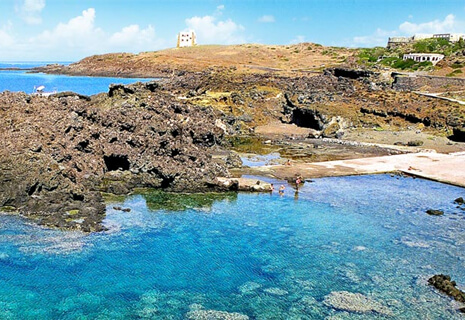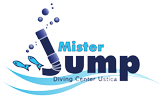Ustica has no sandy beaches but discreetly paths dug into the rock lead, for bathing in creeks and coves or in suggestive areas. Two of these areas fall into the zone A maximum protection of the marine reserve by facilitating a truly extraordinary swim in contact with the fish that now do not fear the presence of man. Cala Sidoti, a long bay of dark pebbles, and Cove are ideal places to make spectacular walks on the water with only the help of a good mask and at most a pair of fins.
The island, caressed by sea currents rich in plankton, has a crystal sea, still clear but also rich in flora and fauna. Diving offer breathtaking scenery: vertiginous descents of the seabed, gentle hills and vast plains, unparalleled beauty caves inhabited by crayfish or cowries, clouds of damselfish, of damsels and vogues, schools of barracudas, groupers and moray eels mighty, rockfish , bream and a thousand other guests and seagrass meadows, sea fans, sponges walls bouquet of anemones, sea daisies and roses of Ustica, armies of crabs, lobsters, cicadas and crustaceans, urchins every shape and color.
Recondite harmony
 The Ustica Island is still one of the most important heritage of our country. Reached in an hour by hydrofoil from Palermo, it rises from the clear waters of the Mediterranean in its black sheen.
The Ustica Island is still one of the most important heritage of our country. Reached in an hour by hydrofoil from Palermo, it rises from the clear waters of the Mediterranean in its black sheen.
Upon arrival, the small port it will immediately immersed in the respectful reception of the islanders who, without having lost nothing of local traditions will help you find a hidden harmony between the silent recesses of a land that knows, still, excite.
Gramsci wrote during his confinement "It 's impossible to imagine the life of Ustica, Ustica's environment, because it is quite exceptional, out of any normal experience of human society." And these are precisely the words that retrace his mind sitting on a cliff at sunset, with his eyes lost in the infinite sea.
Culinary delights
The most famous product are lentils, whose main characteristics are, in addition to the very small size, ease of cooking wich requires no soaking, and especially the intense taste and the typical aroma.The local gastronomic tradition uses it to prepare simple dishes, put it near to vegetables and herbs such as basil or wild fennel.
They are grown on the island since the nineteenth century, in small plots, and fertile land of lava and treated with full manual techniques. They are sown in January and picked in the first half of June. These features and the limited production have caused that the lentils of Ustica became a Slow Food product, wanted by the high quality gastronomy.
Lentils are an essential ingredient of the local cuisine that still reserves many specialties: delicious dishes of fish, figs, capers, incredible “cassatelle” and “giggi”, typical sweet of the island. Granite and ice creams refresh on warm summer evenings. Lemon granita has to be enjoyed. Conventions stipulated by the Diving with different structures will allow you to delight your palate at very attractive terms.
Sport fishing
Besides the wonderful seabed, Ustica offers you the chance of tourism charter boats in company of expert fishermen who will explain all the secrets of this activity, in accordance, however, of the Marine Protected Area Regulation.A nice adventure where you experience the thrill and fascination of the most fun types of fishing and at the same time be in touch with the customs and the typical flavors of the island.
Island tour
 Although diving is the main attraction, the small island of Ustica offers a number of interesting alternative activities.
Although diving is the main attraction, the small island of Ustica offers a number of interesting alternative activities.
For those who love trekking, on top of the mountain “Mount Guardia di Mezzo”, 248 meters above sea level, accessible by a dirt path that passes through the forest of pine trees, you can enjoy a splendid view before descending along the Spalmatore coast and resting near the lighthouse at Punta Spalmatore cooling off in the natural swimming pools that are linked to the sea via an underwater passage.
Many are the marked paths that facilitate the exploration of the island, to explore by foot or by the backs of donkeys, along the paths along the coast or in the green paths of the grove, from which to admire the beautiful landscape that the Island offers us.
Indispensable also a visit to the Fortress, Bourbon remake of a Roman building dated back to 1763 and the Archaeological museum full of interesting artifacts found on the island and from different historical periods.
Caves visits
A must in Ustica is the boat tour of the island (the fishermen at the port offer to take tourists with small boats, suitable to enter the caves) with a visit to the numerous caves that offer a breathtaking sight and packed with special color effects.Starting from the port of Cala Santa Maria southbound meet the first caves, the Azzurra, the Accademia, the Barche and the Thunder one.
It comes, therefore, at Punta Cavazzi one of the panoramic view of the island and continuing you’ll find yourself at Punta Spalmatore where begins the area A (the full reserve of water around the coast) and the “Torre dello Spalmatore”. Continuing the tour, near the “Punta Megna”, you can see the “Scoglio del Medico” (trad. as Doctor Rock), whose legend says that a Saracen king left there his doctor to starve him because he had not been able to heal her daughter. And you can dive in the area, but only with the guides of the reserve.
Protected sea area
Marine protected areas in Italy are 20 altogether and protect approximately 184,000 hectares of sea and about 580 kilometers of coastline.Each area is divided into three types of areas with different degrees of protection.
They consist of marine environments, consisting of the waters, the seabed and the facing stretches of the coast, which are of significant interest to the natural, geomorphological, physical, biochemical, with particular regard to marine and coastal flora and fauna and for the importance of scientific, ecological, cultural, educational and economic significance.
The Ustica Protected Marine Area is divided in:
Zone A (total reserve)
It extends from “Caletta” to “Cala Sidoti” including a sea area more or less parallel to the coast at an average distance of about 350 meters.In this area is forbidden:
- partial removal and damage of geological and mineral formations;
- navigation, access and parking, with ships and boats of any kind and type, as well as bathing;
- fishing both professional sports exercised by any means;
- hunting, capture, collection, corruption and generally any activity that might indicate danger or distress of the animal or plant species, including the introduction of alien species;
- alteration, by any means, directly or indirectly, the environment geophysical and biochemical characteristics of the water, as well as the dumping of solid or liquid waste and generally the release of any substance that could change, even temporarily, the characteristics of the marine environment;
- the introduction of weapons, explosives and of any destructive means or the catch, as well as toxic substances or pollutants;
- activities that can still cause harm, hindrance or disturbance to the achievement of the aims of protection of scientific;
- access from the ground, except in the places where bathing is permitted.
ZONE B (general reserve)
It extends from “Punta Cavazzi” to “Punta Homo Morto”, north sector for a distance of three nautical miles.In this area is forbidden:
- any form of fishing or pickup of the divers with or withour breathing equipment;
- any form of recreational or professional fishing that has not been previously authorized by the Reserve Management.
- underwater photography;
- fishing exercised only with stationary and towed lines.
ZONE C (partial reserve)
It extends the south part of the island, from “ Punta Homo Morto” to “Punta Cavazzi”.In this area is forbidden:
any form of professional fishing that has not been previously authorized by the Reserve Management.
it is allowed:
any form of sport fishing, within the limits allowed by existing legislation, except for the entitlement of the management of the marine impose limits more stringent exclusively aimed at the protection and the increase of biological resources.

 English (UK)
English (UK)  Italiano
Italiano  Français (France)
Français (France) 






